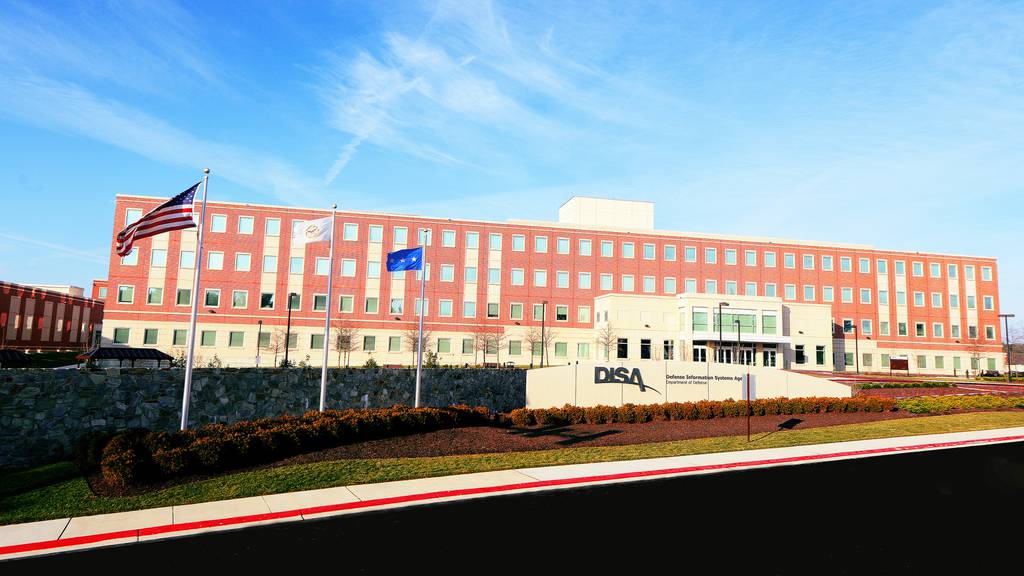WASHINGTON – As each military service constructs its own contribution to Joint All-Domain Command and Control, the Pentagon’s joint IT provider is finding it has an increasing role to play in the department’s massive modernization effort, but is grappling with the future of its legacy command-and-control tools.
“The deeper we dug into JADC2, we realized that more things that the agency does are impacted and part of this,” said Brian Hermann, director of DISA’s services development directorate, in an interview with C4ISRNET. “We’re going to play probably a growing role in JADC2.”
DISA manages the Department of Defense Information Network (DoDIN) and provides global connectivity to the department’s enterprise network. As the services build their systems for Joint All-Domain Command and Control, an effort to provide unprecedented amounts of data to commanders from across the battlefield, Hermann said DISA expects to play a role in network transport, data hosting and ensuring the department has spectrum access to allow networks to function.
“[It’s] how do we make sure that that the sensor data gets to the decision makers and the decision-making capabilities as quickly and cleanly as possible,” Hermann said.
Hermann said he expects DISA’s role to grow specifically to aid the Joint Force’s network transport needs. DISA generally doesn’t focus on tactical transport, rather it’s centered on long-haul, global connectivity back to the DoD network, which allows commanders to receive the information they need. As JADC2 progresses, DISA’s transport role will evolve, he said.
“Now what we have to do is we have to look at the JADC2 requirements for transport and we have to say, ‘What do we do differently?’ Do I need to make them somehow more robust than what I had originally planned our connectivity between theaters or between specific sites?” Hermann said.
DISA will also contribute cybersecurity capabilities for JADC2. It’s developing one capability, known as Thunderdome, a zero-trust cybersecurity initiative that could help solve some of the military’s cybersecurity challenges related to JADC2. DISA recently released a request for whitepapers for Thunderdome and plans to start prototyping “pretty quickly,” Hermann said.
Military officials have said that while JADC2 seeks to make data ubiquitous to warfighters, allowing only authorized users to access the data is tricky. That gets even more difficult when data is crossing different levels of security classification, an area where military officials have said they haven’t seen a viable industry solution that would work on the contested battlefield.
Speaking at the TechNet Augusta conference in late August, DISA director Lt. Gen. Robert Skinner said “identity management is, I would offer, the number one issue that we have got to address within the department in pushing toward zero trust.”
The services are interested in DISA’s work on identity, credential and access management, according to Brig. Gen. Rob Parker, the chairman of the Pentagon’s JADC2 cross-functional team and deputy director of the Joint Chiefs of Staff J-6. Parker said at the Defense News conference earlier this week that a DISA ICAM solution could be available in the next year if properly funded.
DISA is also modernizing two legacy systems that feed into warfighter’s common operating picture, a tool that allows users to have common views of the battlefield. The agency is modernizing its Global Command and Control System-Joint, a battlefield awareness tool, and a force planning tool called Joint Planning and Execution Services, a modernization of a legacy program known as Joint Operational Planning and Execution Services.
According to Hermann, the situational awareness working group on the JADC2 Cross-Functional Team has an ongoing program decision memorandum study exploring the military’s future situational awareness needs. GCCS-J modernization is part of that discussion.
“Those are pending discussions that are ongoing right now,” Hermann said. “So a big part of it is what do we have now in GCCS-J and what do we think it ought to look like. And so we’re part of those discussions we’re looking at how that transition is going on there.”
As it considers its contribution to future U.S. war fighting, DISA is grappling with its portfolio of legacy command-and-control systems that were effective during the last few decades of conflict, but may not be suitable for the data-driven warfare of the future. Hermann said there is “some question” about the role of legacy command-and-control systems moving forward.
“The ability to plan forces in the competition phase, as well as in the hot phases of action, are something [where] we depend upon those legacy tools,” he said. “That said, the architecture of those tools is today not really very JADC2-focused because there are many enclaves around the department that provide separate pieces of the common operational picture that are then stitched together at the enterprise level.”
The goal in the modernization, he added, is to host the capabilities at the enterprise level to increase access, deliver updates and ensure cybersecurity. Until recently, Hermann said, GCCS-J had a separate modernization project known as GCCS-Joint Enterprise, but the Joint Staff redirected the agency to modernize the existing capability incrementally. Moving away from the legacy systems to enable JADC2 is a challenge.
“When you look at demonstrations associated with JADC2, sometimes what you find out is under the covers they’re getting the data from a legacy service that’s already there,” Hermann said.
Mark Pomerleau contributed to this report.
Andrew Eversden covers all things defense technology for C4ISRNET. He previously reported on federal IT and cybersecurity for Federal Times and Fifth Domain, and worked as a congressional reporting fellow for the Texas Tribune. He was also a Washington intern for the Durango Herald. Andrew is a graduate of American University.








